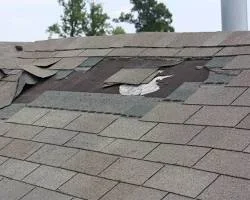This is the second of many articles that help you choose the correct property to rent or buy, from a civil/structural point of view. Read the entire guide here
When it comes to real estate, home rental, property rental, home buying, and property buying, the condition of the roof is a critical factor to consider. A damaged roof can lead to costly structural issues and affect the overall safety of a property. In this article, we'll highlight key indicators of roofing problems, including missing shingles, leaks, and signs of water damage on ceilings and walls. We'll also provide guidance on how to safely inspect a roof and when it's best to call a professional for structural safety.
Identifying Roofing Red Flags
Understanding the signs of roofing issues can help you make informed decisions about your real estate investments. Here are some common red flags to watch out for:
- Missing Shingles: Check for missing, cracked, or curling shingles. These can expose your roof to water damage and weaken its integrity. Shingles should be flat and secure, with no cracks or tears. Missing or damaged shingles can allow water to leak into the roof and cause damage.
- Water Damage and Leaks: Inspect your ceilings and walls for signs of water damage, such as discoloration, bubbling paint, or peeling wallpaper. Water stains or active leaks in your ceiling or walls are clear indicators of a roofing problem. Address leaks promptly to prevent further damage. This could include water stains on the ceiling or walls, or mold growth. Water damage can be a sign of a serious problem with the roof.
- Sagging Roof: This is one of the most important aspects to consider. A visibly sagging roofline can signify structural issues and should be assessed by a professional immediately. some signs of this problem can be
- Uneven roofline: The roofline is the highest point of the roof, where the two pitched planes meet. A sagging roof will have a dip or bow in the roofline.
- Wavy roof: A sagging roof will have a wavy appearance, with the roof dipping and bowing in different areas.
- Cracked or damaged shingles: Shingles on a sagging roof may be cracked or damaged, due to the weight of the roof pushing down on them.
- Overloading: If too much weight is placed on the roof, it can cause the roof to sag or collapse. This can be caused by heavy snow, ice, or rain, or by the weight of construction materials or other objects placed on the roof.
- Wind damage: High winds can damage the roof, tearing off shingles or flashing, or damaging the roof structure.
- Hail damage: Hail can damage the roof, causing dents or holes in the shingles.
- Fire damage: Fire can damage the roof structure, causing the roof to sag or collapse.
A deformed roof is a roof that has been damaged or damaged in some way, causing it to lose its original shape. This can be caused by a variety of factors, including:
Neglect: If a roof is not properly maintained, it can become damaged and deformed over time. The most common type of deformation is deflection, which is when the roof sags or bends. Deflection can be caused by any of the factors listed above, but it is most often caused by overloading.
Safely Inspecting Your Roof
Before climbing onto your roof, ensure your safety. Here's how to conduct a basic roof inspection:
- Use Proper Equipment: Use a sturdy ladder and wear appropriate footwear with good traction.
- Check from the Ground: Start by inspecting your roof from the ground using binoculars. Look for visible damage and missing shingles.
- Climb Safely: If necessary, climb onto the roof carefully, avoiding fragile areas. Walk on the rafters rather than the shingles.
- Document Your Findings: Take photos of any damage you discover for reference.
When to Call a Professional
While some roof inspections can be done by homeowners, certain issues require professional expertise. Here are situations where you should call a roofing professional:
- Complex Repairs: For extensive damage or structural issues, it's best to rely on a professional roofing contractor.
- Roof Replacement: When your roof reaches the end of its lifespan or experiences severe damage, consider a full roof replacement.
- Insurance Claims: If your roof has been damaged due to a storm or other events, consult with a professional to assess the damage and assist with insurance claims.






Comments
Post a Comment